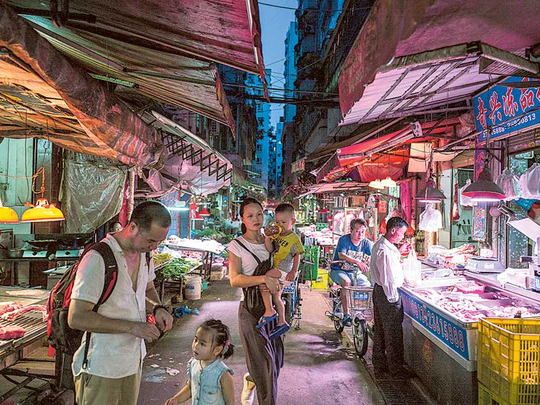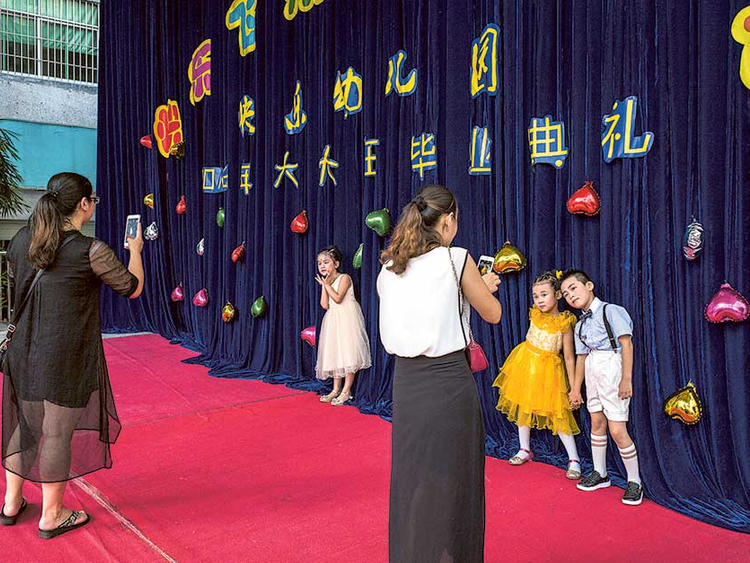
Baishizhou, China: The concrete block buildings that shade the narrow asphalt alleyways of Baishizhou are so closely situated that they are called “handshake” buildings – it is that easy for neighbours to greet one another.
Over the years, the buildings appeared to be cinched even closer by bundles of electrical wires strung from rooftop to rooftop, pulling small urban quarters together into a densely packed tenement village in the heart of Shenzhen, one of southeastern China’s surging metropolises. On the streets, pedestrians dodge cars and bikes during the daily rush, and still larger crowds turn out for the vibrant night markets.
Baishizhou, an organic conglomerate of five smaller urban villages, has for decades served as an enclave of cheap housing for migrant workers and immigrants who have helped support Shenzhen’s rapid economic growth. But the days are numbered for the teeming tenement neighbourhood, home to about 150,000 people: Long-awaited demolition plans have finally begun.
In a city – and country – eager to modernise and redevelop its inner cities, urban villages like Baishizhou are seen by government officials as dirty and backward. Instead, they aim to build gleaming new residential and commercial districts to reflect Shenzhen’s rise.
These new developments would uproot longtime residents who have faced the threat of demolition for years. Baishizhou is in a central district of Shenzhen long valued for its potential for commercial redevelopment. Plans to remake the area began in 2005, and, in 2014, Shenzhen officials marked part of Baishizhou for redevelopment. A factory and office complex in central Baishizhou, the Shahe Industrial District, was scheduled to be razed at the end of April.
The factory remains, and new delays have stalled plans to tear it down.
“It will happen, sooner or later,” says Wu Zhengui, 62, a migrant from Zhejiang province. He has been selling shoes for 14 years out of a storefront on the eastern edge of the Shahe complex, where stores up and down the blocks advertise “demolition sales”.
“I just keep selling my shoes, buying less inventory, and waiting for the government notice to come saying they will finally tear this place down,” he said ruefully.
Until then, life continues as normal in Baishizhou. At night, women gather to wash their laundry at a well outside socialist dormitories, built during Mao’s time, when Baishizhou was still a collectivised farm. Residents set up pool tables in alleys and screen movies on the sidewalks near empty buildings marked for demolition with dark red paint.
Hua Chenling, 54, a recent migrant from Fujian province, opened a barebones fruit store in Baishizhou just a month ago, even though she knew her building was scheduled to be torn down. “I don’t worry about demolition,” she said. “I need to make a living. I just take things month by month.”
Baishizhou has long served as a haven for Shenzhen’s disadvantaged newcomers. Rents are cheaper than in more developed neighbourhoods. An elementary school in the village teaches the children of migrant workers who would otherwise not qualify for Shenzhen’s public schools.
Lively atmosphere
Despite the long-threatened demolition, Baishizhou’s lively atmosphere and low rents continue to lure new businesses and foreign entrepreneurs. There are design studios, boutiques and a hacker space for young techies, and even a nascent night life scene.
“For young people, this is the exciting, hipster place to be. We want to allow other people to see how vibrant and interesting Baishizhou is,” said Mary Ann O’Donnell, who has lived for 20 years in Shenzhen and in 2013 co-founded Handshake 302, an arts space in Baishizhou.
“Worrying about demolition is like worrying about the sky falling, or dying,” said Lan Jiang, 32, who has operated a small computer repair store in Baishizhou for four years.
He has heard about the possibility of demolition since the day he arrived from his native Sichuan province. He sees no reason at this point to oppose the demolitions, or to move. “People like us can’t do anything to change things,” he said. “Policies are never designed to benefit the lowest classes.”
Other urban villages in Shenzhen have been disappearing one by one to make room for lucrative commercial and residential developments. Across town, West Gangxia, a former urban village, was razed in 2009.
Today it is home to modern skyscrapers that make up the skyline of Shenzhen’s central business district.
That is Baishizhou’s fate, too, when the Shenzhen government concludes negotiations with the citizens who own the land rights to the village.
During China’s Great Leap Forward, about 60 years ago, land from Baishizhou’s five villages was collectivised by the state into an agricultural commune.
“It is actually because of how ambiguous the land use ownership is that Baishizhou has been able to survive for so long,” said Du Juan, an assistant professor of architecture at Hong Kong University who is working on a book about urban villages.
Du said that negotiations with villagers could take five to 10 years. For now, residents new and old go about their business, seemingly oblivious to the empty factories nearby marked for demolition.













